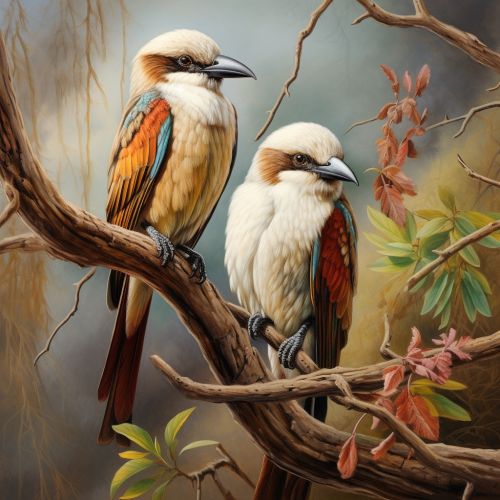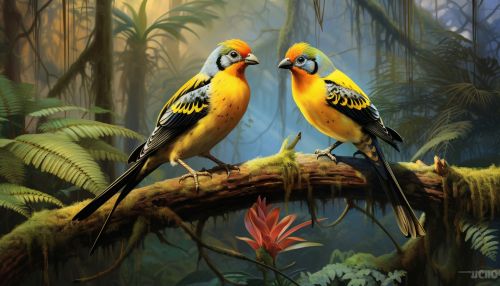The Evolution of Sexual Dimorphism in Birds
Introduction
Sexual dimorphism, the physical differences between male and female members of a species, is a widespread phenomenon in the animal kingdom. In birds, it is particularly pronounced and has been the subject of extensive scientific study. This article will delve into the evolution of sexual dimorphism in birds, exploring the theories and evidence that explain why such differences have developed and how they have influenced bird behavior and ecology.


The Basics of Sexual Dimorphism in Birds
Sexual dimorphism in birds can manifest in several ways, including differences in size, coloration, ornamentation, and vocalizations. These differences are generally the result of sexual selection, a form of natural selection in which traits that increase an individual's chances of attracting a mate or successfully reproducing are favored.
Size
Size dimorphism is common in many bird species, with males often being larger than females. This is thought to be a result of male-male competition, where larger males have an advantage in physical contests over mates or territory. However, in some species, females are larger than males. This is often seen in species where females are the primary defenders of territory or where larger size confers an advantage in resource acquisition or offspring care.
Coloration
Color dimorphism is another common form of sexual dimorphism in birds. Males are often more brightly colored than females, a phenomenon known as dichromatism. This is thought to be a result of female choice, where females prefer brightly colored males. Bright coloration can signal good health or high genetic quality, making brightly colored males more attractive mates.
Ornamentation
Ornamentation, such as long tail feathers or elaborate crests, is another form of sexual dimorphism in birds. These traits are often sexually selected, with females preferring males with more elaborate ornaments. Ornamentation can also play a role in male-male competition, with more ornamented males being more successful in contests over mates or territory.
Vocalizations
Vocal dimorphism, where males and females of a species have different calls or songs, is also common in birds. This is often a result of sexual selection, with females preferring males with more complex or louder songs. Vocal dimorphism can also play a role in territory defense, with different calls or songs being used to signal ownership of a territory or readiness to mate.
The Evolution of Sexual Dimorphism in Birds
The evolution of sexual dimorphism in birds is a complex process, influenced by a variety of ecological, behavioral, and genetic factors. Several theories have been proposed to explain the evolution of sexual dimorphism in birds, including the sexual selection theory, the ecological niche divergence theory, and the genetic correlation theory.
Sexual Selection Theory
The sexual selection theory posits that sexual dimorphism in birds evolved as a result of sexual selection, a form of natural selection in which traits that increase an individual's chances of attracting a mate or successfully reproducing are favored. This theory suggests that males and females of a species evolved different traits because they faced different selective pressures related to reproduction.
Ecological Niche Divergence Theory
The ecological niche divergence theory suggests that sexual dimorphism in birds evolved as a result of differences in the ecological niches occupied by males and females. This theory posits that males and females of a species evolved different traits because they used different resources or occupied different habitats, leading to divergent selection on traits related to resource acquisition or habitat use.
Genetic Correlation Theory
The genetic correlation theory suggests that sexual dimorphism in birds evolved as a result of genetic correlations between traits in males and females. This theory posits that traits that were beneficial in one sex but not the other could still spread in a population if they were genetically correlated with beneficial traits in the other sex.
Impact of Sexual Dimorphism on Bird Behavior and Ecology
Sexual dimorphism in birds has a significant impact on bird behavior and ecology. Differences in size, coloration, ornamentation, and vocalizations between males and females can influence mating behavior, territorial disputes, parental care, and other aspects of bird behavior and ecology.
Mating Behavior
Sexual dimorphism can have a significant impact on mating behavior in birds. Males with traits favored by sexual selection, such as bright coloration or elaborate ornamentation, may have an advantage in attracting mates. Similarly, larger males may have an advantage in physical contests over mates. This can lead to the evolution of complex mating rituals and displays, as males compete to attract females.
Territorial Disputes
Sexual dimorphism can also influence territorial disputes in birds. Males are often larger than females and may have more elaborate ornamentation, which can give them an advantage in physical contests over territory. This can lead to the evolution of complex territorial behaviors, as males compete for control of prime nesting or feeding areas.
Parental Care
Sexual dimorphism can also impact parental care in birds. In species where females are larger than males, females may be the primary providers of parental care, while in species where males are larger, males may take on a greater role in offspring care. This can lead to the evolution of complex parental behaviors, as males and females balance the demands of reproduction with the needs of their offspring.
Conclusion
Sexual dimorphism in birds is a complex and fascinating phenomenon, shaped by a variety of ecological, behavioral, and genetic factors. Through the process of evolution, males and females of many bird species have developed distinct traits that influence their behavior, ecology, and reproductive success. Understanding the evolution of sexual dimorphism in birds provides valuable insights into the forces that shape biodiversity and the complex interplay between genetics, ecology, and behavior.
